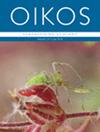High rates of nectar depletion in summer grasslands indicate competitive conditions for pollinators
IF 3
2区 环境科学与生态学
Q2 ECOLOGY
引用次数: 0
Abstract
Competition among pollinators for floral resources is a phenomenon of both basic and applied importance. While competition is difficult to measure directly under field conditions, it can be inferred indirectly through the measurement of floral resource depletion. In this study, we conducted a pollinator exclusion experiment to calculate nectar depletion rates in summer across 16 grassland sites in the German regions of Franconia and Saxony‐Anhalt. Overall depletion rates were estimated at 95% in Franconia and 79% in Saxony‐Anhalt, indicating strong nectar limitation and likely competition among pollinators for nectar. Despite being ubiquitous in our study regions, honey bees were scarce at our sites at the time of nectar sampling. This demonstrates that wild pollinators alone are capable of massive nectar depletion, and the addition of managed honey bees to wild pollinator communities may intensify already competitive conditions. Nevertheless, the manifest diversity of the pollinator communities at our sites indicates that other factors, such as non‐trophic constraints or temporal variation in nectar limitation, can mitigate competitive exclusion despite immediate conditions of acute nectar scarcity.夏季草地花蜜消耗率高,表明传粉昆虫的竞争条件激烈
传粉昆虫之间对花卉资源的竞争是一种具有基础和应用重要性的现象。虽然在野外条件下很难直接测量竞争程度,但可以通过测量花资源损耗来间接推断竞争程度。在这项研究中,我们在德国弗兰肯和萨克森-安哈尔特地区的 16 个草原地点进行了授粉昆虫排斥实验,以计算夏季的花蜜耗竭率。据估计,弗兰肯地区的总体耗尽率为 95%,萨克森-安哈尔特地区为 79%,这表明花蜜受到严重限制,传粉昆虫之间可能存在花蜜竞争。尽管蜜蜂在我们的研究区域无处不在,但在采花蜜时,蜜蜂在我们的研究地点却很少见。这表明,仅靠野生授粉昆虫就能造成大量花蜜枯竭,而在野生授粉昆虫群落中加入人工饲养的蜜蜂可能会加剧已经存在的竞争状况。尽管如此,我们研究地点授粉者群落的明显多样性表明,其他因素,如非营养制约因素或花蜜限制的时间变化,可以缓解竞争排斥,尽管当时花蜜极度匮乏。
本文章由计算机程序翻译,如有差异,请以英文原文为准。
求助全文
约1分钟内获得全文
求助全文
来源期刊

Oikos
环境科学-生态学
CiteScore
6.20
自引率
5.90%
发文量
152
审稿时长
6-12 weeks
期刊介绍:
Oikos publishes original and innovative research on all aspects of ecology, defined as organism-environment interactions at various spatiotemporal scales, so including macroecology and evolutionary ecology. Emphasis is on theoretical and empirical work aimed at generalization and synthesis across taxa, systems and ecological disciplines. Papers can contribute to new developments in ecology by reporting novel theory or critical empirical results, and "synthesis" can include developing new theory, tests of general hypotheses, or bringing together established or emerging areas of ecology. Confirming or extending the established literature, by for example showing results that are novel for a new taxon, or purely applied research, is given low priority.
 求助内容:
求助内容: 应助结果提醒方式:
应助结果提醒方式:


